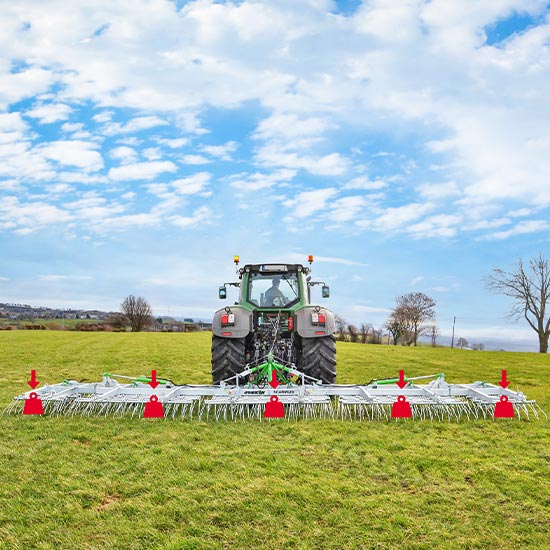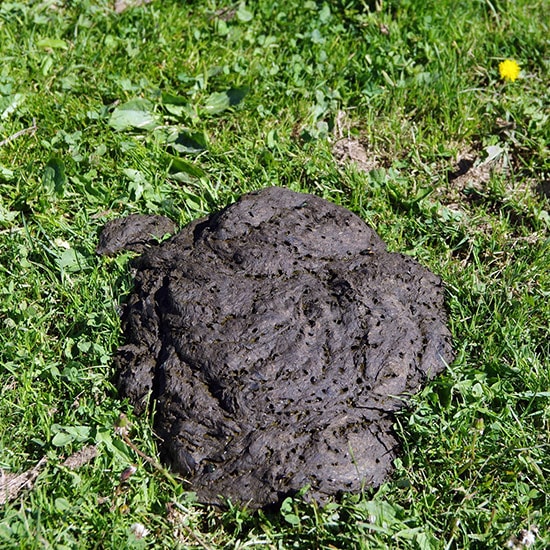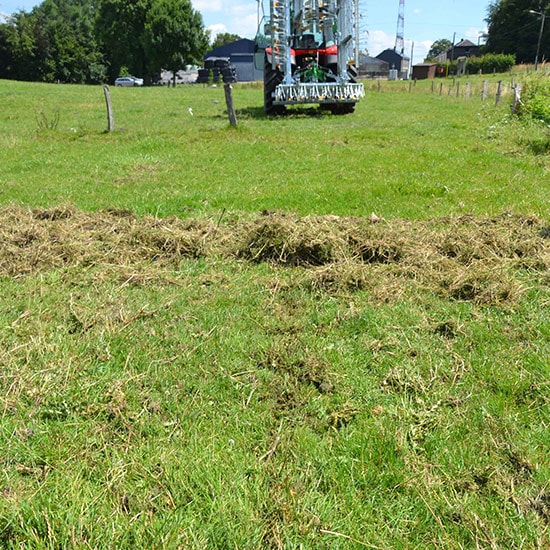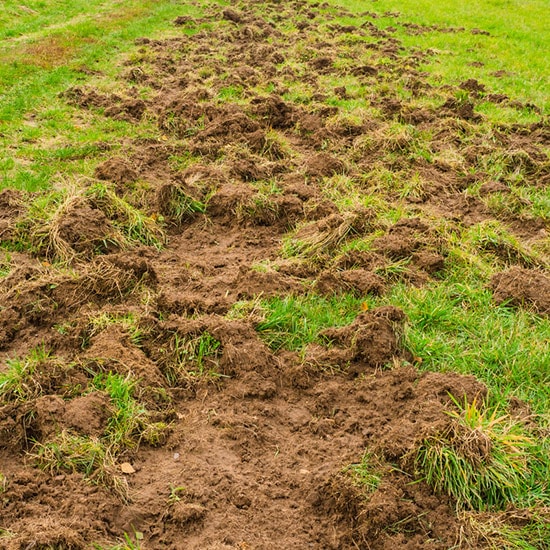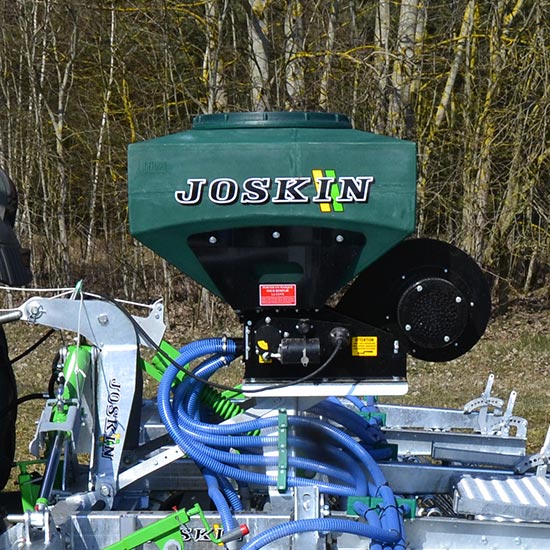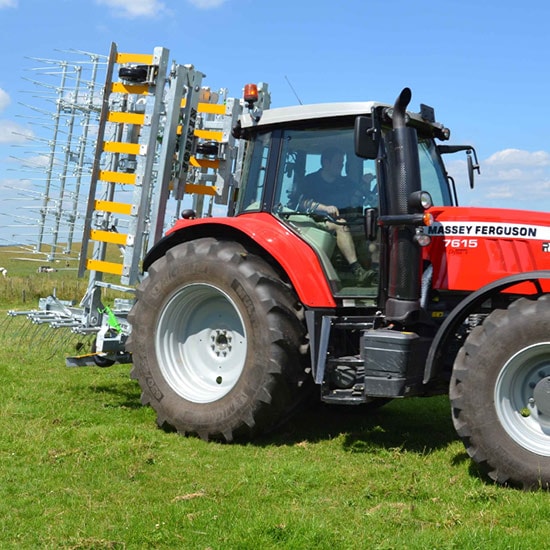Purchase Guide
Meadow aerators
The production of a quality fodder meets many criteria: it must combine the feed value, palatability and digestive quality the cattle need, while meeting yield requirements. Finding this balance is a science in itself. It requires the implementation of appropriate agricultural practices, but also the ability to face the numerous external factors damaging the composition of the meadows.
Well aware of this reality and of the financial consequences that such damage may have, JOSKIN has developed a complete range of implements to maintain and renovate grasslands in order to ensure the production of enough quality grass to the farmers.
It is never easy to choose a machine, so this guide aims to help you find the implement that will best meet your needs according to your meadow specifications and the damage encountered.
What are the Causes of Damages in a Meadow?
Flora is a major indicator of the condition of a meadow. Ideally, the vegetation cover should be homogeneous and its permanent composition should approach:
- 70% of good grass to ensure a dense and productive grass,
- between 10 and 20% of leguminous plants to improve the fodder quality,
- min. 10% of other plants to make the fodder palatable.
Several hazards can however lead to an unbalance and damage the meadow:
- dung
- moss
- molehills
- ground compaction
- felting, dead grass, grass weed, sealing crust,...
- damages of wild boars
- holes in the vegetation cover
- leftovers.
To prevent such an unbalance, a fast and appropriate reaction is needed. It is therefore useful to understand how a harrow works in order to determinate the most suited model to react.
The specific action of each of our harrows is the result of a combination of 5 factors:
How Does a Harrow Work?
The great strength of JOSKIN harrows lies in their ability to face efficiently the various specific situations that may be encountered. Even if all our models are extremely versatile, they all have a specific design in order to face some damage types more precisely and with greater insistence, depending on their intensity and frequency of occurrence.
The specific action of each of our aerators results from the combination of 5 factors:
How to Choose the Most Suitable Aerator?
When choosing an aerator model, it is important to clearly identify the needs. The most appropriate way to do this is to determine what corrective actions need to be taken to restore the balance in the meadow. To facilitate the choice, JOSKIN has developed a guide that easily compares the conditions encountered on a farm with the specificities of the different products in the JOSKIN aerator range. In just 10 clicks, this tool allows you to find the most suitable aerator!
Dung in grazed meadows constitutes fertilizing elements that can be easily made profitable. Dairy cows use only a small portion of the material they ingest and return the rest to the field, creating areas with a high concentration of mineral elements. Unfortunately, these areas are unevenly distributed on the pasture. If the farmer does not react, the odour they emit can not only create areas with leftovers, but also increase the risk of empty spots since the good grass will be smothered. These holes will then be quickly filled in by weeds. The solution is to break up and spread the dung on the meadow, in order to distribute its fertilizing value evenly over the ground. This operation can be carried out all year through. However, it is recommended to do it on a short grass and right before a rainy period for the grass to be quickly "washed" and thus not to lose its palatability.
Moss generally tends to grow massively on soils with a too acidic surface pH. It also multiplies on areas of the meadow that are very shadowy or suffering from a poor soil aeration, the earth then remaining permanently too heavy and too wet. This moss can be easily removed by mechanically scraping the soil surface with relatively flexible tines. This operation is highly recommended to allow the meadow to breathe, increase its nitrification rate and therefore reunite all necessary conditions for the useful grass to grow.
The richer in worms and other micro-organisms your earth, the more likely moles will be attracted. The consequence of this colonization is however the repeated appearance of molehills on the surface. Level these small hills by means of semi-flexible scrapers is then more than recommended. This solution allows to level the ground in order to prevent a premature wear of the mower blades, but also to avoid the presence of earth in the fodder when mowing. If the surface area of the meadow is half covered with earth after the molehills were spread, it is recommended to overseed in order to prevent these areas from being invaded by undesired plants.
On a field, the soil structure is constantly under attack. Whether it is bad weather, pasture trampling or the repeated passage of agricultural machinery, all this inevitably cause a compaction of the soil and its structure. In the autumn (after grazing) and spring, it is then necessary to aerate the soil deeply (> 3 cm) by scraping more aggressively than usual with rigid tines fitted with shares. This process allows the soil to recover a lumpy structure, which ensures a good water and air circulation, and enhances the soil heating, while stimulating its natural biological activity. This practice significantly improves the grassland yield and provides a denser and better quality fodder.
This is a crucial operation for the good health of a meadow. It is done by gently scraping the first few centimeters of soil with successive rows of spring tines, which vibrate when touching the ground. This action ensures a mechanical removal of germinating or grown weeds in order to limit their competition with the implanted crop. Scarifying a meadow also ensures the raking of all the organic residues (dead grass, leaves, etc.) that have come to be mixed with the grass cover. This harmful layer not only asphyxiates the healthy roots, but also prevents water from circulating in the ground, thus enhancing the growth of moss. Combing regularly provides a better aeration of the soil and fortifies the desired grass.
On the same principle, harrowing also makes it possible to remove the sealing crust forming on the surface of the ground after heavy rains followed by a dry period. If it is not broken, this compact crust makes the soil impermeable and favours the stagnation of water on the surface in the event of bad weather, which can drown the existing flora. A last advantage of the scarification is that it prepares the soil for overseeding. The spring tines break up the clods of earth and generate the fine earth that is essential for the seed germination, while slightly leveling the soil surface.
If moles cause a slight difference in level on the surface, wild boars are responsible of much more damages. Depending on their needs, they are used to overturn the earth on more or less large areas with their snout looking up for food (earthworms, rodents, insects, etc.). Depending on the extent of the damages, we talk about roots or grubs. In both cases, the consequences are often heavy for the farmer: bare areas often lead to a more or less large profitability loss and open the door to invasive grass weeds like thistle and dock. The modification of the soil relief slows down the mechanical work and makes it uncomfortable and imprecise, and maximizes the risks of earth in the fodder. The possibilities of stones brought to the surface are also increased, causing a risk of premature wear of the material, or even its breakage. To avoid this, the damages caused by wild boars will have to be repaired as fast as possible. This should be done during dry weather and the soil will have to be scraped by means of a sturdy blade mounted on a half-flexible support.
Because of these multiple attacks, the grass cover does not always remain undamaged after an entire season. It is not uncommon for a homogeneous loss of grass density to be noted or for the appearance of more or less large empty areas to be deplored, with as direct consequence a loss of yield. Depending on the proportion of good grass remaining (at least 30%), overseeding can be considered. This consists in supplementing the meadow flora by introducing a selection of fast germinating and improving species into the gaps before they are naturally filled by unwanted species. The advantage of overseeding is then to maintain production while preserving most of the vegetation in place during the operation. However, two conditions should be met: a prior scraping of the ground to remove undesirable species and the generation of fine earth that is essential for the new seeds (the most cost-effective solution being to equip the harrow directly with a seeder). The soil should also be sufficiently warm and moist to ensure quick germination. Overseeding should therefore be done either in the spring or at the end of the summer to allow the plants to grow enough to resist to the first droughts or frosts. If necessary, it may be wise to take advantage of the trampling of animals to complete the operation, in order to optimise the contact between the seeds and the soil.
Given their specific scope of action, our various harrows are designed to be used in combination with appropriate tractors. In this way, a hitching system that is compatible with these tractors is integrated on the harrow frame. The hitching type of your tractor is therefore also very important.
Like all agricultural machinery, a harrow is an investment and is therefore subject to profitability requirements. Its width is therefore a decisive selection criterion. It must be directly adapted to the surface area of the meadow to be treated. A harrow with an appropriate width will have to work less than an undersized model to cover the same surface area. The repair costs of the meadow per hectare will therefore be lower. Furthermore, all tools will also work less and therefore wear less rapidly.
The power of your tractor is another element to be taken into account when choosing your machine. The harrows have a certain weight. Furthermore, depending on the nature of the task to be carried out, the working depth and the type of terrain, the harrows will require an appropriate traction power.




